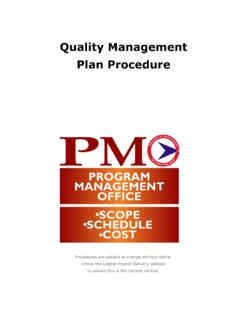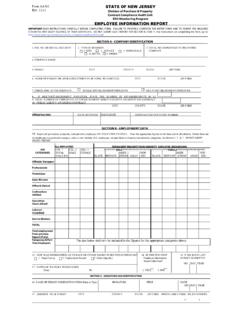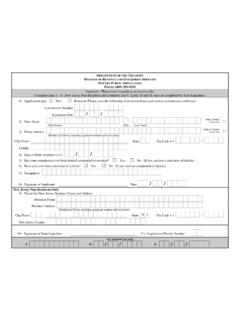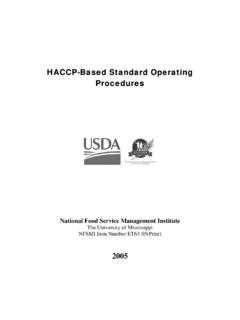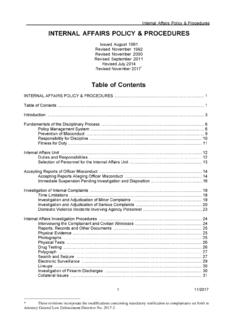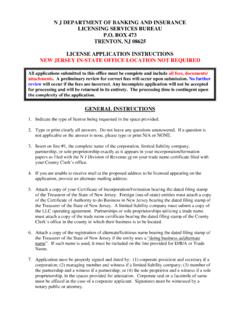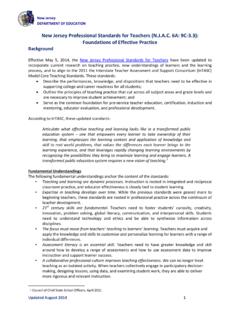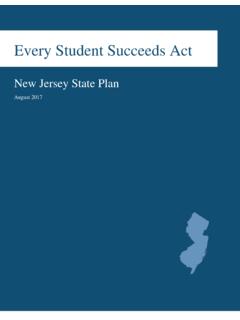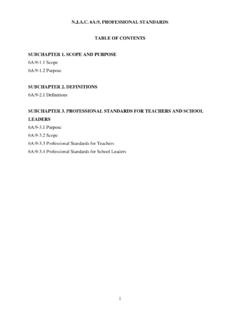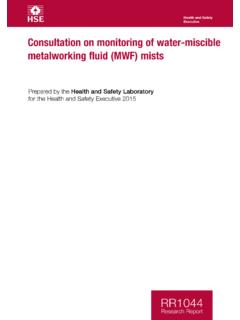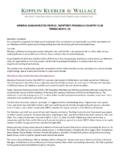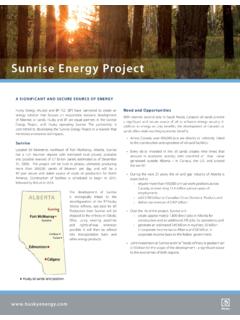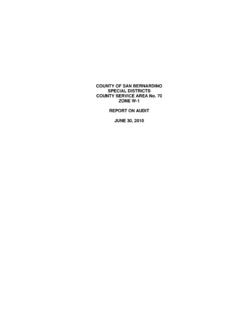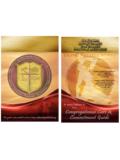Transcription of CHAPTER 3: FORESTRY (N.J.A.C. 7:3)
1 1 CHAPTER 3: FORESTRY ( 7:3) Statutory Authority: 13 through 102; 13 ; 13:1D-9; 13:1L-1 et seq.; 45:1 9; 52:14B-1 et seq., and 54 et seq. Date Last Amended: December 18, 2017 For regulatory history and effective dates see the New Jersey Administrative Code. Table of Contents SUBCHAPTER 1. GENERAL PROVISIONS 7 Construction 7 Severability 7 Definitions 7 Submissions and communications 7 through 7 (Reserved) SUBCHAPTER 2. FORESTATION PROGRAM OF THE NEW JERSEY STATE FOREST NURSERY 7 Scope and authority 7 Distribution of forestation stock to New Jersey landowners 7 Compliance 7 Permitted uses of forestation stock 7 through 7 (Reserved) SUBCHAPTER 3. LIST OF APPROVED FORESTERS 7 Scope and purpose 7 Application procedure, qualifications, and approval criteria 7 Professional services of an Approved Forester 7 Standards of conduct 7 Continuing education 7 Semi-annual reports 7 Removal from the List of Approved Foresters 7 Reinstatement to the List of Approved Foresters 7 Adjudicatory hearing requests SUBCHAPTER 4.
2 7 through 7 (Reserved) 2 SUBCHAPTER 5. FOREST stewardship PROGRAM 7 General provisions 7 Plan criteria 7 Title page 7 Background and goals 7 Property overview 7 Forest stands 7 Management schedule 7 Appendices 7 Submission of a plan, plan amendment, or plan conversion 7 Department review 7 Monitoring and recordkeeping 7 Plan amendments 7 Change in ownership 7 Plan conversions SUBCHAPTER 6. FOREST stewardship ADVISORY COMMITTEE 7 Committee membership 7 (Reserved.) 7 Appointed members; term and compensation 7 Functions and authority of the Committee 7 Organization and conduct of the Committee 7 Authority and responsibilities of the Chair 3 CHAPTER 3 FORESTRY SUBCHAPTER 1. GENERAL PROVISIONS 7 Construction (a) The provisions of this CHAPTER shall be liberally construed to permit the Department to discharge its statutory functions. (b) The provisions of this CHAPTER are not intended to, and do not, relieve any person of the duty to comply with all applicable State or Federal statutes, rules, and regulations, or the terms of any easement or other legal obligation.
3 7 Severability If any section, subsection, provision, clause, or portion of this CHAPTER , or the application thereof to any person or circumstance, is adjudged unconstitutional or invalid by a court of competent jurisdiction, such judgment shall be confined in its operation to the section, subsection, provision, clause, portion, or application directly involved in the controversy in which such judgment shall have been rendered and it shall not affect or impair the remainder of this CHAPTER or the application thereof to other persons or circumstances. 7 Definitions The following words and terms, when used in this CHAPTER , shall have the following meanings unless the context clearly indicates otherwise. "Age" means, with respect to a stand: 1. If the stand is even aged, the mean age of the trees calculated from the year of the stand's establishment; and 2.
4 If the stand is uneven aged, the mean age of the dominant or, if applicable, co-dominant tree species in the stand. "Age class" means an interval into which the age range of trees is divided for classification or utilization. "Age-class distribution" means, with respect to a stand, the location or proportionate representation, or both, of different age classes in the stand. "Agroforestry" means a system of land management that involves deliberate mixture of trees or other woody perennials with crop and animal production to take advantage of economic or ecological interactions among the components. "Approved Forester" means an individual whose name is on the List of Approved Foresters. "Basal area" means the cross-sectional area of: 1. With respect to a single tree, its stem, including the bark, measured at breast height ( feet above the ground), typically expressed in square feet or square meters; and 2.
5 With respect to a stand, or all trees of one or more specified species within the stand, all the trees, measured at breast height ( feet above the ground), typically expressed 4 in square feet or square meters per acre or per other unit of land area. "Biomass" means, with respect to a stand at a given time, the vegetative matter in the stand and is typically expressed in units of volume of wet or dry weight per acre. Depending on the context in which it is used, this term may apply to all vegetative matter in the stand collectively or to a component of the stand, such as a given species of trees or a harvestable forest product. "Canopy cover" means the proportion of the forest floor covered by a vertical projection of the tree crowns, and is expressed as a percent of an area of forest land. Commissioner means the Commissioner of the Department. "Contiguous" shall have the same meaning as defined for this term in the Department of the Treasury's Farmland Assessment Act rules at 18:15, except that no easement that crosses a property and that is held by a public utility or other public entity shall be deemed to disrupt the property's contiguity.
6 "Critical habitat" shall, with respect to a Federally listed threatened or endangered species, have the same meaning as defined for this term in Section 3 of the Endangered Species Act of 1973, 16 1532. "Crown" means the part of a tree or woody plant bearing live branches and foliage. "Crown class" means a category of tree based on its crown position relative to those of adjacent trees. Examples of such classes include dominant, co-dominant, intermediate, and overtopped. Department means the Department of Environmental Protection. "Destruction or adverse modification" shall, with respect to a Federally listed threatened or endangered species, have the same meaning as defined for this term in the USFWS's Endangered Species Committee regulations at 50 CFR "Diameter at breast height" or "DBH" means the diameter of the stem of a tree measured at breast height ( feet above the ground).
7 "Diameter class" or "DBH class" means any of the intervals into which a range of diameters of tree stems or logs may be divided for classification and utilization. "Ecosystem service" means a service rendered by an ecosystem that benefits people. It is specifically a service that is useful to man, as follows: 1. A provisioning service, such as clean air, fresh water, energy, fuel, forage, or fiber; 2. A regulating service, such as long-term storage of carbon; climate regulation; water filtration, purification, or storage; soil stabilization; flood control; or disease regulation; 3. A supporting service, such as pollination, seed dispersal, soil formation, or nutrient cycling; or 4. A cultural service, such as an educational, aesthetic, spiritual, or cultural heritage value, recreational experience, or tourism opportunity. "Farmland assessment" means valuation, assessment, and taxation of land under the 5 Farmland Assessment Act.
8 Farmland Assessment Act means the Farmland Assessment Act of 1964, 54 et seq., and any subsequent amendments. "Federal guidelines plan" means a plan that was approved by the Department prior to December 18, 2017, as satisfying the requirements for forest stewardship plans in the National Forest stewardship Guidelines. "Federally listed threatened or endangered species" means a species listed with a status of "endangered" or "threatened" on the List of Endangered and Threatened species promulgated by the USFWS or other Federal agency pursuant to the Endangered Species Act of 1973, 16 1531 et seq. "Flood hazard area" shall have the same meaning as defined for this term in the Flood Hazard Area Control Act rules at 7 "Forest health" means the perceived condition of a forest or a stand derived from concerns about such factors as its age, structure, species composition, function, vigor, presence of unusual levels of insects or disease, and resilience to disturbance.
9 "Forest inventory" means, with respect to a stand, a characterization of the stand based on data collected from a systematic survey of the stand that: 1. Is designed to provide information about the condition of the stand for use in planning for the management of the stand; 2. Is conducted in accordance with accepted FORESTRY sampling methods; and 3. May be used to show the rate of change of forest parameters and the dynamics of the stand through comparison with data collected in one or more prior inventories, if available. "Forest management" means the practical application of biological, physical, quantitative, managerial, economic, social, and policy principles to the regeneration, management, utilization, and conservation of forest land or of a stand to meet specified goals and objectives while maintaining its sustainability. "Forest productivity" means, with respect to an objective in a forest stewardship plan, the rate of progress toward the desired future condition or outcome.
10 This rate could be a positive or negative value. As an example, if the objective is: 1. To produce woody biomass, this term could be expressed as the net average annual change in the amount of woody biomass, given in cubic feet, board feet, cords, or weight of biomass per acre; or 2. To manage the forest ecosystem so as to enhance a population of a State-listed endangered plant species, such as the Pine Barren Gentian (Gentiana autumnalis), this term could be expressed as the net average annual change in the number of individual plants in the population or in the extent of the population, given in units of area such as square feet. "Forest stewardship plan" means a plan that is prepared and implemented by an owner of forest land and is approved by the Department as conforming to the requirements of 7:3-5. 6 "Forest type" means a category of forest defined by its vegetation, particularly its dominant vegetation as based on percentage cover of trees.
